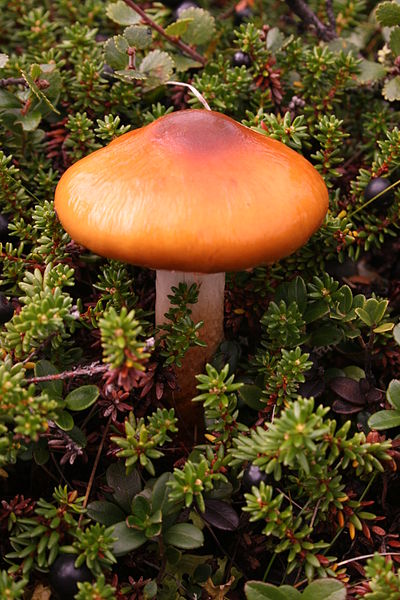Mushroom toxicity
Background
Major Categories
- Early-Onset Poisoning
- Toxicity begins within 2hr of ingestion; clinical course is usually benign
- Late-Onset Poisoning
- Toxicity begins 6hr after ingestion; clinical course is often serious/ possibly fatal
| Mushroom Toxin | Pathologic Effect |
| Amatoxin | Hepatotoxicity |
| Coprine | Disulfiram-like |
| Gyromitrin | Seizures |
| Ibotenic Acid | Anticholinergic |
| Muscarine | Cholinergic |
| Orellanin | Nephrotoxicity |
| Psilocybin | Hallucinations |
Specific Mushroom Type Ingestions
Differential Diagnosis
Causes of acute hepatitis
- Acetaminophen toxicity (most common cause of acute liver failure in the US[1])
- Viral hepatitis
- Toxoplasmosis
- Acute alcoholic hepatitis
- Toxins
- Ischemic hepatitis
- Autoimmune hepatitis
- Wilson's disease
Diagnosis
Early-Onset Poisoning
- Comprises majority of mushroom-induced intoxications
- Symptom onset 30-90 min with hallucinations, lasting 6-8 hrs[2]:
- Isoxazoles (ibotenic acid and muscimol) - dsyarthria, ataxia, muscle cramps
- Psilocybin - euphoria, visual hallucinations, agitation, sympathomimetic Sxs
Clinical Features
- Depends on the type of mushroom ingested
- GI
- Nausea/vomiting/diarrhea
- Resolves within 24hr
- CNS
- Euphoria, hallucinations
- Lasts 4-6hr
- Muscarinic
- SLUDGE symptoms
- Diaphoresis, muscle fasciculations, miosis, bradycardia, bronchorrhea
- Resolves in 4-12hr
- Disulfiram-like effect
- Usually when drinking alcohol
- Flushing, tachycardia, diaphoresis, hypotension
Treatment
- GI predominant symptoms:
- Activated charcoal 0.5-1gm/kg
- Do not give antidiarrheal meds
- CNS predominant symptoms:
- Place in dark, quiet room
- Benzos may be given to pts who are agitated
- Muscarinic predominant symptoms:
- Consider atropine for severe symptoms; 0.5-1mg IV for adults; 0.01mg/kg IV for peds
Disposition
- Discharge once symptoms have subsided
Delayed-Onset Poisoning
- Amanita species causes 95% of deaths
- Toxin inhibits formation of mRNA and is heat stable
- Most frequent species: A. phalloides, bisporigera, magnivelaris, ocreata, verna, virosa[3]
References
- ↑ Ostapowicz G, Fontana RJ, Schiodt FV, et al. Results of a prospective study of acute liver failure at 17 tertiary care centers in the United States. Ann Intern Med. 2002 Dec 17; 137(12): 947-54.
- ↑ Rolston-Cregler L et al. Hallucinogenic Mushroom Toxicity. Apr 08, 2015. http://emedicine.medscape.com/article/817848-overview.
- ↑ Enjalbert F et al. Treatment of Amatoxin Poisoning: 20 year retrospective analysis. J tox Clin Tox 2002 40(6):715-767.





